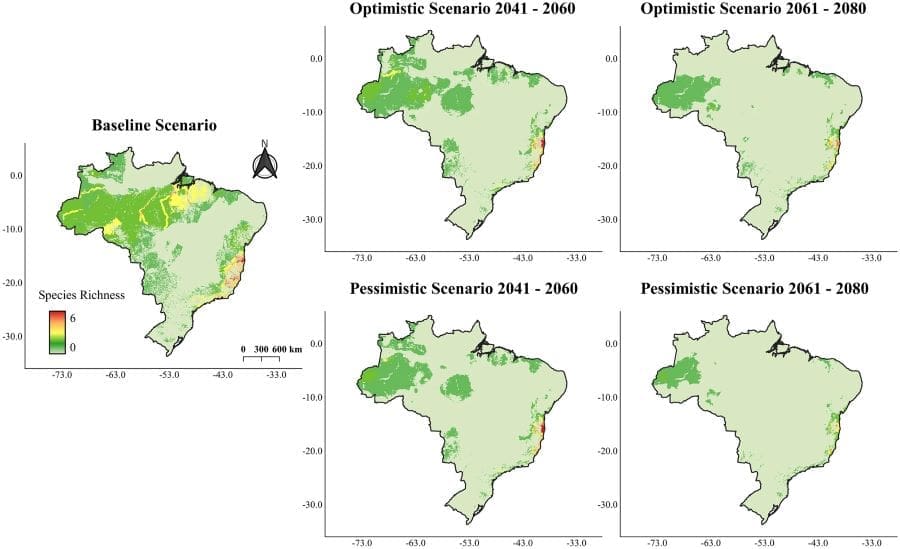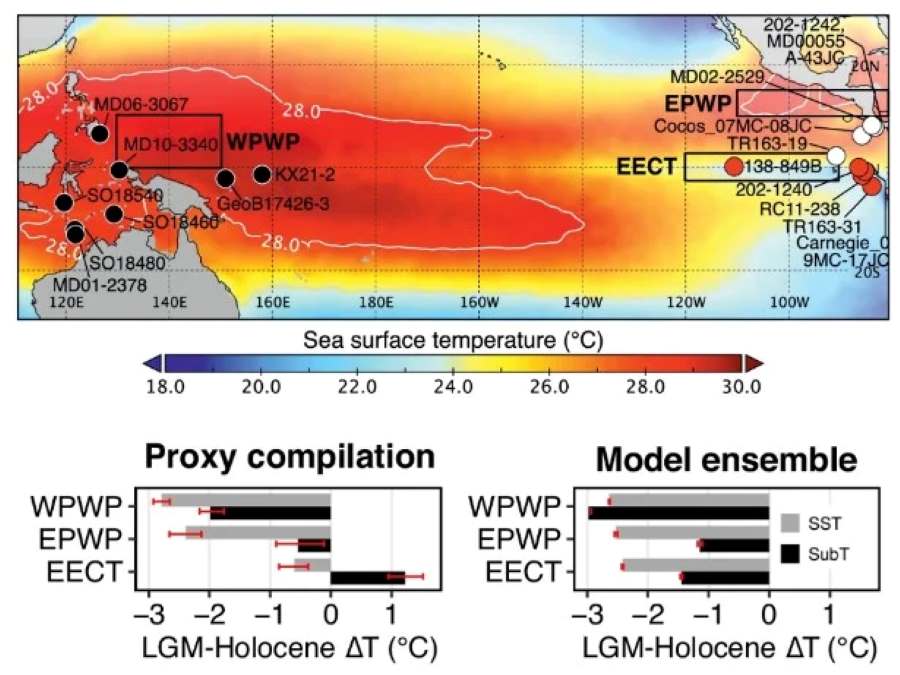Conservation efforts for Brazilian primates under threat from climate change and habitat loss
Brazilian primates face escalating threats as climate change and deforestation combine to erode their habitats.
A recent study highlights how these twin pressures are driving significant losses in suitable habitats for endangered primates, with devastating implications for their survival.
Primates are particularly vulnerable to habitat fragmentation and loss due to their reliance on forest ecosystems. Protected Areas (PAs) serve as vital refuges for these species, especially endemic primates with limited geographic ranges. Researchers have now examined the extent to which PAs can mitigate habitat loss under various climate scenarios spanning the present to 2080.

The study, published in Scientific Reports, analyzed the geographic distribution of 35 endangered primate species using species distribution models. Baseline data were compared with projections for four future climate scenarios, ranging from optimistic to pessimistic. The results paint a stark picture: most species could see a loss of more than 90% of their suitable habitats under all scenarios, with some Amazonian species projected to lose over 98% of their current range.
PAs currently play a limited role in protecting these primates. Under baseline conditions, only 8.6% of PAs were found to support more primate species than expected by chance, and this capacity diminishes in future scenarios. While PAs harbor between one and six species today, their effectiveness will likely shrink as climate change intensifies, leaving already threatened taxa with even fewer options for survival.
Amazonian primates, in particular, face alarming habitat declines. These species, often confined to specific regions, are among the most at risk. Without increased conservation measures, the cascading effects of climate change and deforestation will push them closer to extinction.
The findings underscore a critical need for expanding and strengthening the PA network to ensure long-term population viability. “Given the restricted geographic distribution and current population decline for most taxa, we emphasize the need to increase the number of PAs to ensure population viability and prevent future extinction,” the researchers emphasize.
This study highlights the urgency of coordinated conservation strategies that address not only habitat preservation but also broader environmental policies. In the absence of swift action, Brazil’s primate diversity – a cornerstone of its ecological heritage – may become an irretrievable loss.
Journal Reference:
Gomes, L.B., Gonçalves, G.R., Velazco, S.J.E. et al. ‘Conservation challenges for Brazilian primates and the role of protected areas in a changing climate’, Scientific Reports 14, 31356 (2024). DOI: 10.1038/s41598-024-82717-9
Source: Scientific Reports
Glacial cooling reduces tropical Pacific upper ocean zonal gradients
National Taiwan University – A research team led by National Taiwan University used geochemical indicators from deep-sea sediments to reconstruct the upper ocean zonal gradients in the tropical Pacific during the last glacial period, providing valuable constraints for future climate projections.
Their findings are published in the journal Communications Earth & Environment.
The tropical Pacific Ocean plays an important role in the global climate system. El Niño events wreak havoc worldwide by causing extreme weather and droughts. To better prepare for future changes in this region, it is crucial that climate models can accurately simulate changes in the mean state of the tropical Pacific. Unfortunately, most state-of-the-art climate models fail to reproduce the observed warming pattern of sea surface temperatures in the tropical Pacific over the last century.

To further evaluate the performance of these models under different atmospheric CO2 levels, postdoctoral researcher Alicia Hou (currently at University of Bordeaux) and Associate Professor Sze Ling Ho from the Institute of Oceanography National Taiwan University, along with their collaborators from the University of Bremen and Queen Mary University of London, collated paleotemperature estimates from past climates characterized by contrasting atmospheric CO2 levels for comparison with model simulations (see fig.). These paleotemperature estimates are inferred from geochemical indicators analyzed on microfossils extracted from deep-sea sediments, which are also known as paleoclimate proxies.
Before performing proxy-model comparison, the team first used Argo data to ensure that several temperature indices commonly used in paleoclimate reconstruction can indeed capture changes in the upper ocean thermal conditions of the tropical Pacific during El Niño and La Niña events.
They then generated a multi-model ensemble using simulations from seven state-of-the-art models based in institutions in North America, Europe, and Asia, under the auspices of the Paleoclimate Modelling Intercomparison Project (PMIP).
The proxy-model comparison results indicate that, similar to the warming observed over the last century, these models were unable to reproduce the tropical Pacific cooling pattern when atmospheric CO2 levels were about half of today’s levels. The discrepancies between proxies and models may stem from the fact that the models overestimate sea surface temperature changes in the eastern tropical Pacific.
The proxy results also suggest that the western Pacific may warm more than the eastern Pacific if greenhouse gas emissions continue unabated in the future. In summary, this study demonstrates the usefulness of paleoclimate proxies in improving climate models and informing future climate projections.
Journal Reference:
Hou, A., Jonkers, L., Ford, H.L. et al. ‘El Niño-like tropical Pacific Ocean cooling pattern during the last glacial maximum’, Communications Earth & Environment 5, 587 (2024). DOI: 10.1038/s43247-024-01740-w
Source: National Taiwan University
Other science articles published this week
River-lake ecosystems exhibit a strong seasonal cycle of greenhouse gas emissions
Wang, S., Wu, S., Dong, Y. et al. (2024) | Communications Earth & Environment | DOI: 10.1038/s43247-024-01912-8
What, how and where: an assessment of multi-level European climate mitigation policies
Bellanca, M. (2024) | npj Climate Action | DOI: 10.1038/s44168-024-00200-7
The cost of recovering Australia’s threatened species
Reside, A.E., Carwardine, J., Ward, M. et al. (2024) | Nature Ecology & Evolution | DOI: 10.1038/s41559-024-02617-z
Seasonal phase change of the North Atlantic Tripole Sea surface temperature predicted by air-sea coupling
Yu, H., Cheng, S., Huang, J. et al. (2024) | npj Climate and Atmospheric Science | DOI: 10.1038/s41612-024-00882-0
Advancing symbolic regression for earth science with a focus on evapotranspiration modeling
Li, Q., Zhang, C., Wei, Z. et al. (2024) | npj Climate and Atmospheric Science | DOI: 10.1038/s41612-024-00861-5
Unraveling the roles of jet streams on the unprecedented hot July in Western Europe in 2022
Li, X., Zheng, J., Wang, C. et al. (2024) | npj Climate and Atmospheric Science | DOI: 10.1038/s41612-024-00880-2
Impact of irrigation on farmworker’s heat stress in California differs by season and during the day and night
Parajuli, S.P., Biggs, T., de Sales, F. et al. (2024) | Communications Earth & Environment | DOI: 10.1038/s43247-024-01959-7
Global disparities in transboundary river research have implications for sustainable management
Sahana, M., Dhali, M.K. & Lindley, S. (2024) | Communications Earth & Environment | DOI: 10.1038/s43247-024-01928-0
Sub-daily scale rainfall extremes in India and incongruity between hourly rain gauges data and CMIP6 models
Saikranthi, K., Radhakrishna, B. & Rajeevan, M.N. (2024) | npj Climate and Atmospheric Science | DOI: 10.1038/s41612-024-00885-x
Exploring the green patent system in China from the perspective of achieving the dual carbon goal: development, challenges and prospective enhancements
Xu, Q., Xie, Y. & Ying, H. (2024) | Humanities and Social Sciences Communications | DOI: 10.1057/s41599-024-04279-5
Recovery in soil carbon stocks but reduced carbon stabilization after near-natural restoration in degraded alpine meadows
He, G., Liu, X., Li, Y. et al. (2024) | Scientific Reports | DOI: 10.1038/s41598-024-82434-3
Examining the impact of globalization and natural resources on environmental sustainability in G20 countries
Wang, C., Mahmood, H. & Khalid, S. (2024) | Scientific Reports | DOI: 10.1038/s41598-024-81613-6
Urban resilience assessment framework and spatiotemporal dynamics in Hubei, China
Liang, Y., Cheng, Y., Ren, F. et al. (2024) | Scientific Reports | DOI: 10.1038/s41598-024-82895-6
Contributions of climatic factors and vegetation cover to the temporal shift in Asian dust events
Zhou, W., Wang, H. & Ge, Q. (2024) | npj Climate and Atmospheric Science | DOI: 10.1038/s41612-024-00887-9
Spatiotemporal patterns and drivers of orchard meadow loss in South Tyrol, Italy
Schönafinger, A., Egarter Vigl, L. & Tasser, E. (2024) | Scientific Reports | DOI: 10.1038/s41598-024-81077-8
Potential backfiring effects of Marine Protected Areas on kelp herbivory
Reis, B., Arenas, F., Sánchez-Gallego, Á. et al. (2024) | Scientific Reports | DOI: 10.1038/s41598-024-82557-7
Network structures and mitigation potential of trade linked global agricultural greenhouse gas emissions
Liu, K., Wang, P., Zhang, B. et al. (2024) | Scientific Reports | DOI: 10.1038/s41598-024-82050-1
Vertical land motion is underestimated in sea-level projections from the Oka estuary, northern Spain
Li, T., García-Artola, A., Shaw, T.A. et al. (2024) | Scientific Reports | DOI: 10.1038/s41598-024-82692-1
Strategic model for integrating biogas a framework for sustainable energy integration in agro-industries
Nahwani, A., Soeprijanto, S. & Widodo, E. (2024) | Scientific Reports | DOI: 10.1038/s41598-024-83181-1
Effects of future climate and land use changes on runoff in tropical regions of China
Xue, S., Guo, X., He, Y. et al. (2024) | Scientific Reports | DOI: 10.1038/s41598-024-81754-8
Urban Water-Energy consumption Prediction Influenced by Climate Change utilizing an innovative deep learning method
Wang, D., Zhang, Y. & Yousefi, N. (2024) | Scientific Reports | DOI: 10.1038/s41598-024-81836-7
Prediction of change in suitable habitats of Senna obtusifolia and Senna tora under climate change
Chen, Y., Luo, C., Huang, X. et al. (2024) | Scientific Reports | DOI: 10.1038/s41598-024-81883-0
The effect of CO2 ramping rate on the transient weakening of the Atlantic Meridional Overturning Circulation
C. Hankel (2025) | Proceedings of the National Academy of Sciences | DOI: 10.1073/pnas.2411357121
Persistent humid climate favored the Qin and Western Han Dynasties in China around 2,200 y ago
C. Qin, B. Yang, A. Bräuning, F. Charpentier Ljungqvist, T.J. Osborn, V. Shishov, M. He, S. Kang, L. Schneider, J. Esper, U. Büntgen, J. Grießinger, D. Huang, P. Zhang, S. Talento, E. Xoplaki, J. Luterbacher, N.C. Stenseth (2025) | Proceedings of the National Academy of Sciences | DOI: 10.1073/pnas.2415294121
Divergence time and environmental similarity predict the strength of morphological convergence in stick and leaf insects
R.P. Boisseau, S. Bradler, D.J. Emlen (2025) | Proceedings of the National Academy of Sciences | DOI: 10.1073/pnas.2319485121
Aerosol light absorption alleviates particulate pollution during wintertime haze events
J. Wu, N. Bei, Y. Wang, X. Su, N. Zhang, L. Wang, B. Hu, Q. Wang, Q. Jiang, C. Zhang, Y. Liu, R. Wang, X. Li, Y. Lu, Z. Liu, J. Cao, X. Tie, G. Li, J. Seinfeld (2025) | Proceedings of the National Academy of Sciences | DOI: 10.1073/pnas.2402281121
Abalones at risk: A global Red List assessment of Haliotis in a changing climate
Peters H, Ralph GM, Rogers-Bennett L (2024) | PLoS ONE | DOI: 10.1371/journal.pone.0309384
Orbital and suborbital temperature variability in the central Mediterranean across the Pliocene/Pleistocene transition
Zanola E, Rodrigues T, Bonomo S, Ferretti P, Fornaciari E, Di Stefano A, et al. (2024) | PLoS ONE | DOI: 10.1371/journal.pone.0310684
Change in sediment transport regime of the Keelung River in Taiwan induced by the operation of Yuanshantze flood diversion tunnel
Lee T-Y, Teng T-Y, Lee J-Y, Pan Y-W, Chen M, Chiu C-C (2024) | PLoS ONE | DOI: 10.1371/journal.pone.0311551
Soil acidity and fertility status of surface soils under different land uses in Sayo district of Oromia, western Ethiopia
Regasa A, Haile W, Abera G (2024) | PLoS ONE | DOI: 10.1371/journal.pone.0316009
Widespread inconsistency in logger deployment methods in coral reef studies may bias perceptions of thermal regimes
Rich WA, Glanz JS, Mele G, Burt NJ, Carvalho S, Doo SS, et al. (2024) | PLOS Climate | DOI: 10.1371/journal.pclm.0000517
CAECENET: An automatic system processing photometer and ceilometer data from different networks to provide columnar and vertically-resolved aerosol properties
Herrero del Barrio C, Román R, González R, Cazorla A, Herreras-Giralda M, Antuña-Sánchez JC, et al. (2024) | PLoS ONE | DOI: 10.1371/journal.pone.0311990
Diatoms-endoparasite association in fish from the marine pacific coast of Colombia (Buenaventura)
Potosi-Pai V, Agudelo Morales CE, Benavides-Montaño JA (2024) | PLoS ONE | DOI: 10.1371/journal.pone.0312015
Featured image credit: kjpargeter | Freepik




